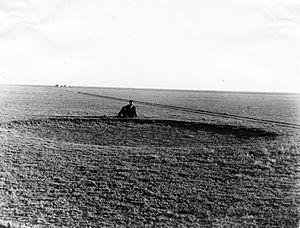Buffalo wallow facts for kids

A buffalo wallow is a natural dip in flat prairie land. It collects rainwater and water that runs off the surface. These unique spots are also called bison wallows.
For thousands of years, huge herds of American bison (often called buffalo) lived and grazed across North America's vast prairies. They usually left very few lasting marks on the land. However, buffalo wallows are a special exception. These ancient dips can still be seen today on flat prairie lands.
Originally, these natural dips were just temporary watering holes for many wild animals. This included the mighty American bison. But when bison started wallowing in these shallow water holes, things changed. They would drink from and bathe in the water.
Each time a bison left a wallow, it carried mud away on its body. This slowly made the wallow bigger and deeper. Also, when bison rolled around, they rubbed off hair, natural body oils, and skin cells. This debris stayed in the water and soil after the water dried up.
Over time, this debris built up in the soil. It formed a special layer that water could not easily pass through. This meant that rainwater and runoff stayed in the wallow for much longer. This standing water attracted even more wildlife. Even if the water was still, thirsty animals would eagerly drink it.
Buffalo wallows are not just made by American bison. The Asian water buffalo and the African buffalo also create similar wallows.
Contents
How Buffalo Wallows Formed
Buffalo wallows are not just random puddles. They are unique land features created by bison. These animals played a big role in shaping the prairie landscape. Their actions turned simple dips into lasting water sources.
The Role of Wallowing Bison
When bison wallow, they roll around on the ground. They do this for many reasons. It helps them remove insects and shed their winter coats. It also helps them spread their scent. This rolling action is what created and deepened the wallows.
As bison rolled, they scraped away soil. They also compacted the ground beneath. This made the bottom of the wallow harder. Each visit by a bison helped to enlarge the depression. It also made the soil less permeable to water.
Creating a Water-Holding Layer
The constant wallowing left behind a mix of mud, hair, and skin cells. This organic material mixed with the soil. Over many years, this mixture formed a dense layer. This layer was almost like a natural sealant. It prevented water from soaking deep into the ground.
Because water could not drain away easily, it stayed in the wallow longer. This meant the wallows became reliable water sources. They were important for bison and other animals. Even in dry periods, wallows often held water.
Buffalo Wallows in Culture
Buffalo wallows have sometimes appeared in stories and books. They show how these natural features were part of life on the prairie. They often represent a connection to nature and the past.
A Prairie Childhood Story
In 1953, a writer named Charles Tenney Jackson published a book. It was called The Buffalo Wallow: A Prairie Childhood. This book was an autobiographical novel. It told the story of two young cousins growing up. They lived during pioneer times in Nebraska. Their favorite secret spot was a buffalo wallow. It was a special place for them to play and hide.

